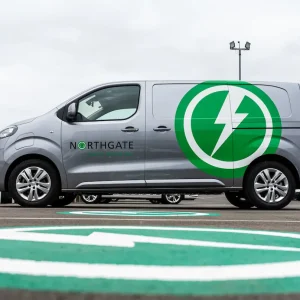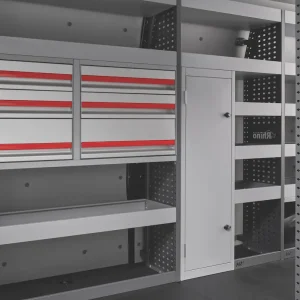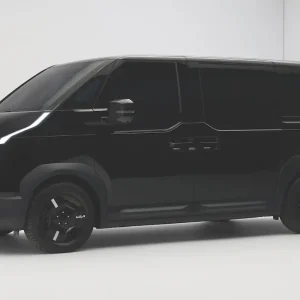In the UK van market the Ford Transit is the undisputed king.
Therefore, when a new generation of the model that has dominated the sector for half a century is in the pipeline, the industry takes notice.
What Van? was given an exclusive insight into the thinking behind the new line-up when we talked to Ford Transit chief engineer, Barry Gale.
The panel van version of the Transit will make its debut at the Commercial Vehicle Show in Birmingham’s NEC on 24 April in short-wheelbase form but a concept passenger carrying derivative, the Tourneo, was on display at the Geneva car show in March.
New look
The design looks radical – sleek and stylish and a departure from the Transit’s heritage as the nation’s ubiquitous practical workhorse.
But the blue oval brand insists none of the van’s traditional functionality has been sacrificed.
“You can see what the van looks like from the Tourneo,” says Gale. In the past, largely because of the huge numbers of Transits in the fleet sector, its utilitarian characteristics have dominated.
“It has always been square, functional, now it’s more stylish like the cars,” Gale says.
The new Transit has something in common with Dr Who’s Tardis, according to Gale.
“It looks smaller but inside it can carry the same amount,” he claims. This includes 8’ by 4’ timber sheets and 3-metre pipes.
“We’ve not compromised functionality,” he says.
Good sport
Ford’s passenger cars have a reputation as being good to drive and the brand has worked to impart a sporty feel to the latest Transit’s performance too by incorporating elements of the popular Transit Sport Van series as well as increasing interior comfort and refinement.
Gale says the new Transit is more relaxing to drive and quieter than its predecessors. The steering wheel is now adjustable for both rake and reach, a feature not included on previous incarnations, and the driver’s seat can be moved further backwards and lower to accommodate taller, larger drivers.
In bringing the commercial vehicle template closer to that of the car range, Ford will offer the van with a choice of three trim levels. As well as the major corporate customers, the manufacturer wants the new model to appeal to owner/drivers looking for a stylish vehicle they’re happy to park outside their house.
But in moving upmarket, Gale stresses Ford will be careful not to alienate the Transit’s core, bread and butter market.
“We always recognise the need for an entry-level model,” he says, suitable for large fleets such as the Post Office, for example.
Ford has set itself ambitious goals in both increasing the new Transit’s desirability while holding on to “all that has made Transit great” such as low insurance and servicing costs. And selling shed loads of vans.
“We’re not compromising on volume,” says Gale “We want to sell even more in the UK, Europe and the rest of the world. We wouldn’t spend all this time and effort without increasing sales.”
Market leader
The Transit’s dominance of the UK market is staggering. In total 56,363 units were shifted in 2011, a rise of 22% year-on-year. In both the medium and heavy van segments it outsold its nearest competitors, the Vauxhall Vivaro and Mercedes Sprinter respectively, by two to one.
Gale claims van drivers and owners are more concerned with their vehicles’ appearance than they’ll care to admit despite often claiming that “they don’t care what it looks like”.
He makes the point that mid-sized vans will continue to be bought in bulk by large fleets but three years down the line they will return to market, when a degree of desirability with individual buyers and small businesses will stand them in good stead in the used sector.
As yet the manufacturer has not analysed the residual value prospects of the new Transit, but Gale says: “I can’t think of any reason why the RVs won’t be as good (as the current model).”
Ford is not yet quoting CO2 or fuel consumption figures but Gale says “great efforts” have been made to improve them.
The current Euro5 Econetic SWB Transit boasts class-leading CO2 emissions of 178g/km coupled with fuel consumption of 43.4mpg – a claimed 10% improvement over the Euro4 vintage.
Most of the 2.2-litre Euro5 powertrains will be carried over to the new Transit. 
Gale says the 155hp version, which is currently only available in rear-wheel drive, will feature on front-wheel drive vans too.
To illustrate the step up in specification levels on the forthcoming Transit, he says the vans will feature bedliners to protect load areas. This idea came from feedback from pick-up customers who said the plylining not only offered protection but was also easy to clean.
Materials for the cabin will match those used in the car range and going up the trim ladder, options will include rear-view cameras and lane departure warnings.
Gale is quick to acknowledge the benefit to Ford’s commercial vehicle operation of being able to make use of the innovations that first appear in the car division.
“The advantage of being part of a global company is that the cars bring the technologies in,” he says.
Synchronicity
The new Transit will be available with a voice activated phone system that will first appear in the B-max passenger car in September.
The Sync system enables users to connect mobile phones and music playing devices by Bluetooth or USB, make hands-free telephone calls and select music using voice commands.
Ford claims it can automatically transfer contacts from a connected Bluetooth to the vehicle, allow calls to be activated through voice commands and read text messages aloud from connected mobile phones by using Bluetooth.
Already launched in the US, Ford expects the system to be fitted to at least 3.5 million vehicles in Europe by 2015.
Sync also enables the new Emergency Assistance feature, which Ford claims will allow occupants to contact emergency services in more than 30 countries, in the correct language, through the vehicle’s GPS locator.
Roll out
Following the launch of the SWB Transit at the UK CV Show in April, Ford will reveal more models at the Hanover Commercial Vehicle Show in September and the rollout will continue into 2013.
The range, like the current line-up, will eventually include long wheelbase derivatives, minibuses, combis and double cab vans but specifications and preferences for different body styles are likely to vary between European markets.
In the UK Ford expects the base model to dominate sales because more than 80% of volume goes to fleets. It says the sportier trims will appeal to retail customers. However, the brand stresses the entry-level model will itself be generously specced with, for example, roof rails included for the first time.
Gale names the Renault Trafic, the Vauxhall Vivaro, the Volkswagen Transporter and the Mercedes-Benz Vito as the “key competitors” for the first of the new Transits to come to market.
But he refutes the suggestion that Ford benchmarked the new van against competitors’ models, stressing that, in many areas, such as steering, the current Transit already leads the commercial vehicle field.
“We didn’t compare it with other vans but with cars. There’s no point in looking at other vans where the Transit is already the best.”
But Gale acknowledged the competition is much stiffer now than when he first worked on the Transit in 1992, when he claims there were only about three vans to choose from. Market segmentation has also increased, where there used to be only two lengths and two heights on offer there are now four of each.
The new Transit promises to take a radical new direction. This is a brave move from Ford and, as ever, the market will determine
its success. But having dominated the commercial vehicle sector for so long with its ability to meet customer requirements and demand, it’s a safe bet the manufacturer knows what it is doing. We wait with baited breath.





